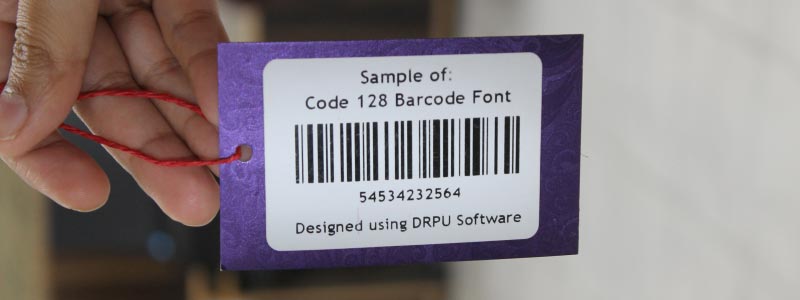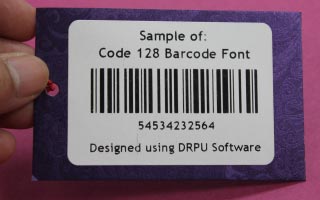Another Articles of Code-128 Barcode
Some Important Points of CODE-128
Code 128 is a continuous barcode, meaning that it does not contain any fixed start or stop characters. Instead, it uses a set of code structures known as "code sets" to represent the data. There are three different code sets in Code 128, each with its own set of characters.
Code Set A includes uppercase letters, digits, and some special characters such as punctuation and control characters. Code Set B includes uppercase and lowercase letters, digits, and some punctuation characters. Code Set C is used for encoding numeric data only, and it encodes two digits per symbol.
To encode data in Code 128, the appropriate code set is selected based on the type of data being encoded. The barcode is then constructed by encoding each character in the data using the appropriate code set. The barcode is typically surrounded by a quiet zone, which is a blank space around the barcode to ensure that there is no interference with the reading process.
Code 128 is capable of encoding large amounts of data in a small space, which makes it ideal for use in applications where space is limited, such as on small product labels. It is also widely used in logistics and supply chain management, as it can encode data such as product codes, lot numbers, and shipping information.
Advantages:
One advantage of Code 128 over other barcodes is that it is a self-checking barcode. This means that the barcode contains a checksum digit that is calculated based on the data encoded in the barcode. When the barcode is scanned, the checksum digit is recalculated, and if the recalculated digit does not match the digit in the barcode, it is assumed that there was an error in the reading process.
Another advantage of Code 128 is that it is a widely accepted standard in the industry. This means that many scanners and other barcode reading devices are capable of reading Code 128, making it a convenient choice for many applications.
Limitations:
Code 128 does have some limitations. One limitation is that it is not capable of encoding graphics or images, as it is a purely alphanumeric barcode. Another limitation is that it requires a relatively large quiet zone compared to other barcodes, which can limit its use in certain applications.
In summary, Code 128 is a high-density, variable-length linear barcode that can encode alphanumeric data. It is widely used in logistics and supply chain management, and is a self-checking barcode with a widely accepted standard in the industry. While it does have some limitations, it remains a popular choice for many applications.
Applications of CODE-128 Barcode
Code 128 is a high-density linear barcode symbology used in various industries, including shipping, logistics, retail, and healthcare. It is a versatile barcode that can encode a large amount of data in a small space, making it ideal for tracking products and inventory, as well as for automated data collection and management.
Some of the most common applications of Code 128 barcode include:
-
Retail:
Code 128 barcodes are widely used in retail for inventory management, price labelling, and tracking shipments. Retailers use barcode scanners to quickly scan the barcode and update their inventory database, allowing them to keep track of their stock levels and reorder products as needed.
-
Automotive:
In the automotive industry, Code 128 barcodes are used for tracking parts and components during the manufacturing and assembly process. By scanning the barcode on each part, manufacturers can ensure that the right part is used in the right place, reducing the risk of errors and defects.
-
Healthcare:
In the healthcare industry, Code 128 barcodes are used for patient identification, medication management, and tracking medical equipment. By scanning the barcode on a patient's wristband or medication, healthcare professionals can access critical information about the patient's medical history and treatment plan.
-
Shipping and Logistics:
Code 128 barcodes are commonly used in the shipping and logistics industry for tracking packages and shipments. Shipping companies and logistics providers use barcode scanners to scan the barcode on each package and update their systems with the package's location and delivery status.
-
Library and Education:
Code 128 barcodes are used in libraries and educational institutions for book and asset tracking. By scanning the barcode on each book or asset, librarians and educators can keep track of their inventory levels and ensure that items are not lost or misplaced.
-
Government and Military:
Code 128 barcodes are used by government agencies and the military for asset tracking and inventory management. By scanning the barcode on each item, agencies and the military can track their inventory levels and monitor the movement of assets.
-
Manufacturing:
Code 128 barcodes are used in the manufacturing industry for tracking work-in-progress (WIP), finished goods, and raw materials. Barcode scanners are used to scan the barcode on each item, allowing manufacturers to track their inventory levels and production progress.
Overall, Code 128 barcode is widely used in various industries for its ability to encode a large amount of data in a small space, as well as its high level of reliability and accuracy.
Structure of CODE-128 Barcode
Code 128 is a high-density linear barcode that can encode a wide range of characters including alphanumeric data, special characters, and control codes. It is a variable length barcode, meaning that it can encode data of varying length. The structure of Code 128 barcode is based on three barcode character sets: Code Set A, Code Set B, and Code Set C. Each set represents a group of characters that can be encoded in the barcode.
-
Code Set A:
Code Set A contains 103 characters including uppercase letters (A-Z), digits (0-9), and special characters such as space, period, dollar sign, plus sign, percent, and others.
-
Code Set B:
Code Set B also contains 103 characters including lowercase letters (a-z), digits (0-9), and special characters such as space, period, dollar sign, plus sign, percent, and others.
-
Code Set C:
Code Set C contains only numeric digits (0-9) and is used to encode numeric data in pairs. Each pair of digits is represented by a single Code Set C character.
-
To encode data in Code 128, the barcode scanner reads each character in the data and determines which Code Set to use based on the character's ASCII value. If the ASCII value of the character falls within the range of Code Set A, the scanner switches to Code Set A to encode the character. Similarly, if the ASCII value of the character falls within the range of Code Set B, the scanner switches to Code Set B to encode the character. If the data contains only numeric digits, the scanner switches to Code Set C to encode the data more efficiently.
-
In addition to the three Code Sets, Code 128 also includes special characters for encoding control codes, shift characters, start/stop characters, and checksum characters. The start/stop characters indicate the beginning and end of the barcode, while the checksum character is used to verify the accuracy of the encoded data.
-
Code 128 supports four different barcode densities, including Code 128A, Code 128B, Code 128C, and Code 128 Auto. The barcode density determines the size of the barcode and the amount of data that can be encoded. Code 128A and Code 128B can encode any ASCII character, while Code 128C is used only for numeric data. Code 128 Auto automatically switches between Code 128A and Code 128B based on the data being encoded.
The Structure of a Code 128 barcode is as follows:
- Start character: Every Code 128 barcode starts with a start character that indicates which Code Set is being used to encode the data.
- Data characters: The data characters represent the encoded data, which can be alphanumeric or numeric depending on the Code Set being used.
- Checksum character: The checksum character is used to verify the accuracy of the encoded data. It is calculated using a complex algorithm that takes into account the values of each character in the barcode.
- Stop character: Every Code 128 barcode ends with a stop character that indicates the end of the barcode.

Code 128 Barcode is different from other Barcodes
Code 128 is a high-density, variable-length, continuous, alphanumeric symbology. It is used to encode information such as product codes, serial numbers, and other data that needs to be quickly and accurately scanned. Compared to other barcode types, Code 128 offers several advantages.
-
High density:
Code 128 can encode a large amount of data in a relatively small space. It can encode up to 128 characters, including all upper and lower case letters, numbers, and special characters.
-
Variable length:
Code 128 can encode variable-length data, meaning that the barcode can adjust its size according to the amount of data it needs to encode. This makes it a flexible option for encoding different types of data.
-
Wide range of characters:
Code 128 can encode all ASCII characters, making it suitable for encoding text data as well as numerical data.
-
High accuracy:
Code 128 uses a checksum digit to ensure the accuracy of the encoded data. This reduces the risk of errors during scanning and increases the overall reliability of the barcode.
-
Industry standard:
Code 128 is widely used in a variety of industries, including logistics, manufacturing, and healthcare. This makes it a recognized and trusted barcode type.
-
Multiple subsets:
Code 128 has three subsets (A, B, and C), which allow it to encode different types of data efficiently. Subset A is used for uppercase letters, Subset B is used for uppercase and lowercase letters, and Subset C is used for encoding numerical data.
-
Compact size:
Code 128 can be printed at a relatively small size while maintaining high readability. This makes it suitable for applications where space is limited, such as on small product labels or in inventory management systems.
-
Compatibility:
Code 128 is compatible with a wide range of barcode scanners, making it a flexible option for use in different scanning environments.
Compared to other barcode types, such as Code 39 and Codabar, Code 128 offers higher density, variable length encoding, and a wider range of characters. However, it may not be as widely recognized as other barcode types, such as UPC or EAN codes, in certain industries. Additionally, Code 128 requires specialized software and equipment to generate and print, which may be a limitation for some users.
Posted By: Techsavvy | Updated On:
